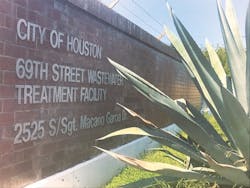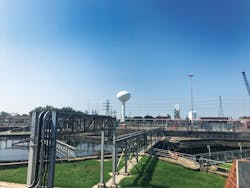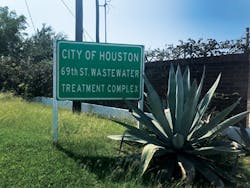Houston Resolution
Bob Crossen is managing editor for WWD. Crossen can be reached at [email protected].
Last August, Hurricane Harvey smashed the Gulf Coast in Houston and became the second wettest cyclone in U.S. history. Neighborhoods were devastated by the flooding, and the National Guard was called in to rescue many people stranded by the floodwaters.
During that period, water and wastewater treatment facilities dealt with their own sets of challenges. Sidney Bomer, Houston wastewater treatment plant manager, was on vacation when he saw the news of the impending storm and began an action plan that would prepare facilities in Houston for the hurricane.
While the plan worked well, there were some hiccups. Some operators were stuck at a plant, requiring a boat rescue, and there was damage to electrical and pumping equipment at some facilities.
One Year Later
Bomer said operations at the facilities he oversees are back to normal, albeit with a few changes since last fall.
“Everything is going pretty well,” Bomer said. “Still a little road ahead of us, but we’re doing pretty good and pretty well overall.”
One of the struggles, as often is the case in the event of natural disasters and emergency relief, has been working with the Federal Emergency Management Agency to get reimbursed for Hurricane Harvey-related emergency costs. The process requires a lot of paperwork, red tape and time to see the return on the expenses.
Despite that, Bomer said that recovery from the hurricane was fast. Some facilities took longer to get back up to speed than others because the service areas were still flooded. Traveling from plant to plant and then from building to building within facilities was the biggest challenge following the storms. Floodwater made certain areas untraversable, but once waters subsided, evaluation was the first step.
Bomer said upper management conducted engineering surveys of all facilities to double check the damages to equipment and to determine what items needed to be serviced, upgraded or replaced.
“From my end, we added those things to the Harvey list to get repaired under Harvey,” Bomer said. “It was mostly electronics, switchgear
and some pumps. I don’t remember us having too many blower issues. It was mostly pumps and switchgear issues.”
Flooding struck Houston again in June 2018, but Bomer said it did not directly affect his facilities. Those around the area did have some difficulties, but no major damages were reported.
New Approach
Many plant manager would say that it is impossible to prepare for a storm of the magnitude of Hurricane Harvey. After all, it was the wettest cyclone to hit the continental U.S. with 52 in. of rainfall. But that has not stopped Bomer and Houston facility management from trying to be even more proactive than they were last August.
“Our mentality is to work on our consolidation efforts a little more vigorously, to take some plants off-line and move them to other plants, especially ones in the low-lying service areas,” Bomer said. “We’re looking at moving a lot of our electronics and switchgear to the 500- to 1,000-year floodplains so we get it up.”
Bomer said there also are discussions about elevating a lot of other equipment along with the switchgear to reduce floodwater intrusion and damage to equipment.
As for the consolidation plans, Bomer said much of that is in engineering design phases at the moment to determine which facilities to consolidate, ensure facilities can handle increased flows and what, if any, capital improvements would be necessary to facilitate a consolidation plan.
When it comes to preparing for future storms, Bomer said he has worked on improving staging locations and the equipment that will be accessible there, particularly vehicle fueling. By setting them up earlier and ensuring they are more easily accessible, operators can be proactive rather than reactive.
Similarly, service contracts are being reviewed, as they were saving graces for the facilities Bomer oversees.
“They’re always looking at improving the contracts to make it more user-friendly for when we have an event like we did,” Bomer said. “That really saved our bacon last time. … We were very fortunate that they had the foresight to add certain language in the contracts to help us.”
General Improvements
Beyond recovery, Bomer said Houston facilities still are following the capital improvement plan, as most of those improvements have been years in the making. That said, the capital purchasing process has sped up. Rather than waiting for designs for certain installation, the equipment is being purchased for quicker installations, essentially to swap out like-for-like.
“It doesn’t require design, but it requires a lot of money,” Bomer said. “These pumps, these blowers, and some of the switchgear is quite expensive. Now switchgear, the minute you touch it, you’ve got to bring it to code so that requires some design. What we’ve done is gone around to all the plants and found what didn’t require design so we can get it purchased.
It’s a new way forwards to get new equipment.”
Meanwhile, the normal capital improvement program process carries on, and larger design changes are completed on the schedule already put in place, although some of those will be subject to change as the consolidation plan becomes more clear. With Harvey behind him, Bomer sees a good future.
“We already saw what can happen at the worst end; now we’re going to see what can happen at the best side,” Bomer said.


